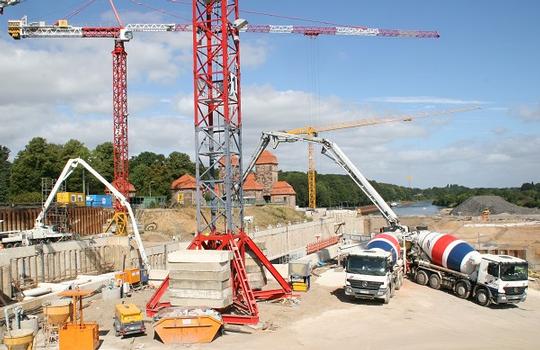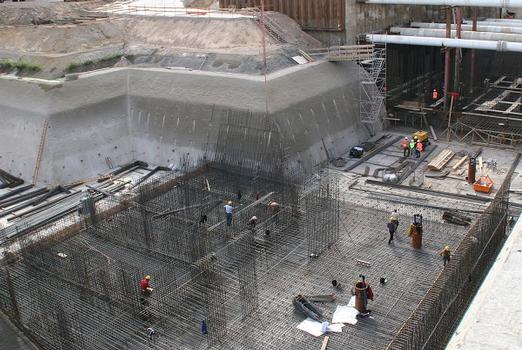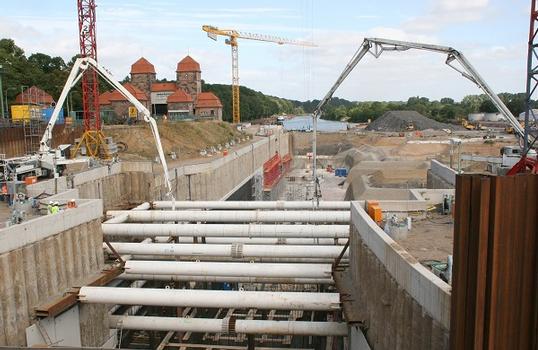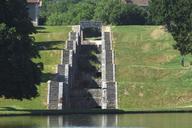Minden Lock: Beginning of Concrete Works
After one hundred years, the shaft lock at the Minden waterway junction has become obsolete. Now CEMEX Deutschland AG delivered ready-mixed concrete for the first invert concreting of the more efficient replacement structure.
Minden in the northeast of North Rhine-Westphalia is an important transport hub: a shaft lock, built between 1911 and 1914, connects the Mittelland Canal with the Weser - an essential passage for inland shipping. However, the dimensions of the existing lock structure - effective length of the lock chamber 85 meters, chamber width 10 meters - no longer meet current requirements. This is because in the future, 110-meter-long large motor cargo ships should also be able to overcome the height difference of 13.30 meters from the Weser to the Mittelland Canal.
That is why the new construction office for the expansion of the Mittelland Canal in Hanover has commissioned the Federal Waterways and Shipping Administration to build a new high-performance lock. This is being built about 52 meters to the east of the old shaft lock, which will remain in full operation during construction.
A special feature of the Minden Weser lock: It will be designed as an economizing lock with three economizing basins, which will bring water savings of about 60 percent. One lock requires 25,400 cubic meters of water, which is taken from the Mittelland Canal. The usable length of the new lock chamber is 139 meters, the chamber width 12.50 meters. The system allows upstream and downstream sluicing in about 37 minutes.
CEMEX Deutschland AG is supplying the large construction site on behalf of Johann Bunte Bauunternehmung GmbH & Co. KG from Bad Bentheim in delivery consortium with ready-mix concrete. A total of around 100,000 cubic meters of a wide range of concrete types will be used in the highly complex construction project, half of which will be supplied by CEMEX. The main quantity will be used in 2013. At that time, the contractor will also call for the chamber wall concrete and a self-compacting concrete (SCC) for pouring the fixtures.
So far, CEMEX's Petershagen supply plant has delivered shotcrete to stabilize the basin slopes and bored pile concrete, among other things. During the construction of a new frame bridge over the outer harbor, which connects the construction yard to the western part of the city, the bridge superstructure was made of fair-faced concrete.
"The particular design challenges so far have been the shape of the excavation pit, whose slopes were stabilized with the shotcrete, and the high demands on the quality of the fair-faced concrete for the bridge," says Björn Kranz, site manager at Johann Bunte Bauunternehmung.
The recipe of an underwater concrete was designed by CEMEX technologist Romanus Diedrich together with the laboratory technicians of the supply partner. The special building material was installed below the waterline by a diver and serves as an interlocking mortar for connecting armourstones in front of the sheet piles. Romanus Diedrich: "We used construction chemical admixtures to ensure that the material would not dissolve in the water. Visibility during installation was more than modest, and the diver had to rely entirely on his sense of touch."
On September 5, the first of a series of large-scale concrete pours was scheduled: CEMEX produced 1,350 cubic meters of concrete of compressive strength class C20/25 and consistency F3 for the invert of the lock chamber in a joint supply arrangement.
"As of today, the earthworks have been completed and the solid construction will begin, for which we are scheduling fifteen months," explained construction manager Björn Kranz. "In the winter, we will not interrupt the work as much as possible - of course, this is also a challenge for the concrete suppliers. But I am confident, because our cooperation is very constructive."
The first invert concreting was an extraordinary challenge, because it had to be concreted fresh in fresh, and the supply chain could not be interrupted under any circumstances. Nine ready-mix concrete mixers were used by the CEMEX disposition to guarantee the continuous supply to the construction site. Two truck-mounted concrete pumps M52 and M42 supported the paving operation. At an hourly rate of 110 cubic meters of concrete, twelve contractor employees concreted the first of nine longitudinal sections two meters thick. Two more layers of invert will follow in the next few weeks, so that the lock chamber invert will be a total of 5 meters thick, and the wall will have a thickness of 4.50 meters.
"The tolerance limit for concrete quality is very low, and the monitoring effort is high," Romanus Diedrich emphasized. "The Bunte company and we perform a very close-meshed inspection." To ensure that the heat of hydration in the core of the massive invert sections does not exceed the limit of 53°C, the fresh concrete must not be warmer than 24°C. In addition, the concrete technologists chose a cement CEM II/A 32.5 N - LH/NA with low heat development, produced at the Dortmund cement plant of CEMEX Deutschland AG.
Björn Kranz: "The special features of this project are the size of the construction site, the immense quantities of concrete and the high quality requirements. But the great technical effort is worth it, because the Weser lock at Minden is designed for a service life of 100 years."
References
Structure Types
Relevant Websites
- About this
data sheet - Product-ID
6053 - Published on:
08/10/2012 - Last updated on:
15/03/2022







